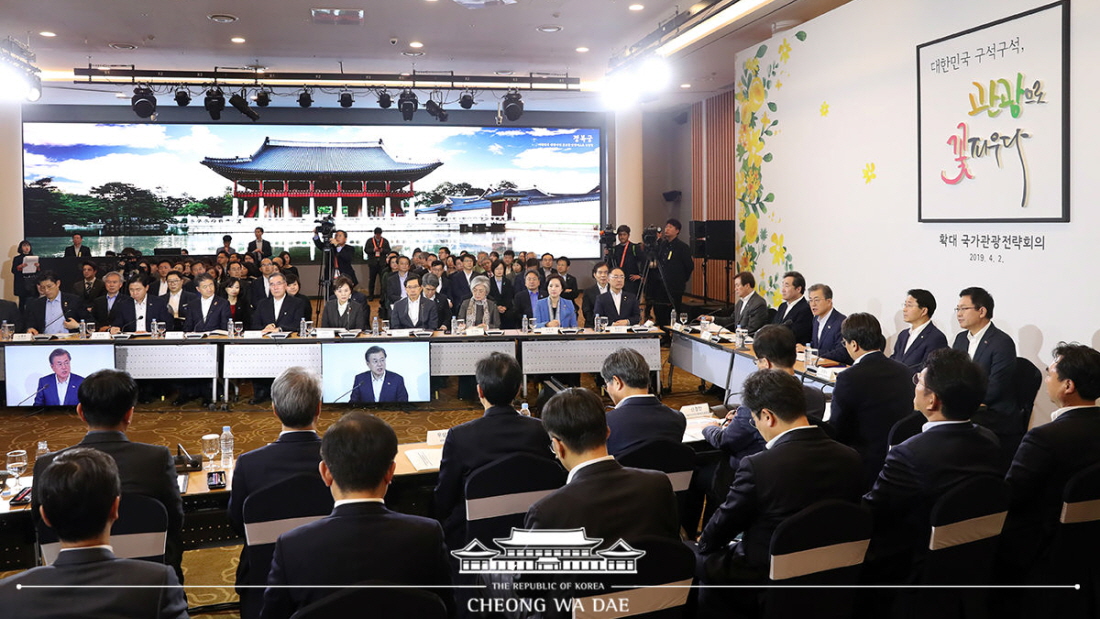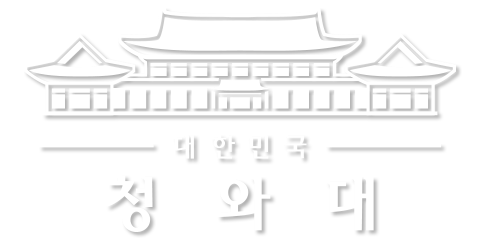이 웹사이트는 제19대 대통령 임기 종료에 따라 대통령기록관이 「대통령기록물 관리에 관한 법률」에 의해 이관받아 서비스하는 대통령기록물입니다. 자료의 열람만 가능하며 수정 · 추가 · 삭제는 불가능합니다.
다만, 「개인정보보호법」에 의하여 개인의 정보를 보호받기 원하시는 분은 관련 내용(요청자, 요청내용, 연락처, 글위치)을 대통령 웹기록물 담당자(044-211-2253)에게 요청해 주시면 신속히 검토하여 조치해 드리겠습니다. 감사합니다.
SPEECHES & REMARKS
BRIEFINGS

Good afternoon everyone. It is significant that this expanded tourism strategy meeting is being held here in Incheon’s Songdo International City, the Republic of Korea’s first free economic zone.
Korea is an attractive nation. It possesses diversity and dynamism in all areas, including history, culture, the economy and the environment. Its heritage dates back hundreds of thousands of years, ranging from dinosaur fossils to the latest information and communication technology. It features diverse culture and also beautiful nature with four distinct seasons.
The Korean people are known for their openness and kindhearted welcoming of guests. Tourism is a sphere that should win people’s hearts and minds. Only if people around the world feel fondness and empathy toward us will they spend their time and money to visit Korea. In that regard, we are equipped with very good conditions.
Actually, when I meet with foreign nationals, I can sense their favorable impressions of Korea have grown very much recently.
In particular, they view very favorably the high level of civic consciousness of Koreans who helped resuscitate democracy in a peaceful manner after the candlelight revolution. Last year, the PyeongChang Winter Olympics’ success as a peace Olympics helped raise awareness and favorable impressions of Korea even higher.
Positive interest in the Republic of Korea generated by Hallyu, the Korean Wave, has been even more explosive. Whatever country you go to, you can hear talk of K-pop and K-dramas.
Enthusiastic Hallyu fans consider Korea a travel destination worth visiting. Many cities and places across the country have become popular tourist attractions for them: Busan, Daegu, Gwangju and Ilsan, the hometowns of BTS members; Seoul’s Gangnam District from Psy’s hit song; and the wheat field in Gangwon Province where the actor Won Bin held his wedding. The percentage of Hallyu tourists now surpasses 10 percent of all inbound foreign tourists.
Another reason to visit Korea is e-sports. Tickets for a 26,000-seat e-sports competition held here in Incheon in 2018 sold out, and 34 percent of those went to foreign tourists.
There is no border between the soft power of culture and arts and the hard power of economic and technological prowess.
Several days ago, Her Majesty the Queen of the Belgians came here to the Incheon Free Economic Zone during her visit to Korea. Many such leaders and professionals continually visit this place to experience firsthand Korea’s advanced ICT technology.
Korea went through an accelerated and compressed economic growth process during the short period when it took off to become an advanced nation from an impoverished country that gained independence after World War II. For this reason, many countries want to learn from and share our economic growth experience. It is a source of great strength as well.
Korea is also tremendously popular as a shopping destination, where travelers can shop for food, clothing, cosmetics and healthcare services as well as appliances and mobile phones that utilize cutting-edge technology. All of these serve as the foundation of Korea’s tourism industry.
The tourism industry is a key driver of economic growth. As one of the world's three major export sectors, its employment inducement coefficient is more than twice that of manufacturing. In addition, the industry provides opportunities for foreign tourists to purchase our products.
Experiencing our natural landscape, culture and goods as well as the warm-hearted generosity of Koreans helps increase favorable impressions of Korea, which in turn leads to revisits and voluntary promotion. As such, a virtuous cycle is now in the making.
Our national tourism strategy should start precisely at this point. Only when we accurately recognize the merits our country possesses – the aspects of Korea that people around the world may find appealing – will it be possible to plan an effective national tourism strategy. Only after clearly defining the objective – what kind of economic and social effects can be achieved through tourism – can we devise corresponding strategies.
Numerous challenges lie ahead of us: As the global tourism market, especially that of the Asia Pacific region, expands, some leading countries such as the United States, Australia and China are channeling all of their efforts into revitalizing tourism.
However, issues connected to the situation surrounding the Korean Peninsula caused a precipitous fall in Chinese group tours, dealing a serious blow to our country's tourism industry overall, which was a wrenching experience for Korea.
Like trade or winning overseas contracts, tourism has now also entered an era of all-out global competition. It is necessary for us to win the competition in order to emerge as a country with a tourism account surplus.
Korea and other Asian nations are each other’s largest tourism consumers. Though still not back to previous levels, the number of inbound Chinese tourists is again trending upward. In addition, the successful conclusion of aviation talks between Korea and China has laid the foundation to advance our bilateral tourism to a new level.
India has the second largest population in the world with around 1.37 billion people, and some 68 million of them hold passports. With the number of its outbound tourists estimated to reach 50 million in 2020, the country possesses an immeasurable growth potential as a tourism market. We need to make India a new main market for our tourism industry by making the most of our New Southern Policy and the 2019 Korea Culture & Tourism Festival slated for this month.
Expanding exchanges with ASEAN member states also constitutes a significant chance for our tourism industry to leap forward. If we take advantage of various opportunities this year, such as the Year of Mutual Exchanges between Korea and the Philippines, the ASEAN-ROK Commemorative Summit and the Mekong-ROK Summit, demand from ASEAN tourists will increase still more.
Korea has cultural and technological strengths. We need to upgrade the standards of our tourism services by fusing mobile technologies as well as information and communication technology to keep up with changing tourism trends. In this regard, it is necessary to expedite the establishment of a smart tourism infrastructure, which makes services related to transport, language, reservation and payment available entirely on a smart phone.
The areas visited by foreign tourists are mostly limited to metropolitan Seoul, Jejudo Island and Busan. I urge local governments to play a leading role in the tourism industry by focusing on contents that highlight features unique to their regions, including medical tourism, maritime travel, experiential tourism, cruise travel and music tourism.
First of all, the Government will select one major city or provincial region and develop it into a world-class travel destination following Seoul and Jejudo Island and foster four other districts, counties or local cities as regional tourism hubs.
We will help improve the tourism capacity of regional areas by supporting tourism-related business ventures; tour dure, local tourism cooperatives; and youth startups.
Since travel is the Korean people’s favorite leisure activity, we will ensure that tourism fills its role of providing people rest by expanding subsidies for workers’ domestic vacations and increasing financial assistance through the Munhwa Nuri Cards, pre-paid cash cards provided to low-income households for cultural expenses.
Paradoxically, the Korean Peninsula – the last remaining territory in the world still divided by Cold War rivalry – can use peace tourism and eco-tourism as a means to leap forward.
Security-focused DMZ tourism already set a record by attracting a total of 3.17 million visitors in one year. If peace and ecological tourism is added to this, tourism demand is expected to rise as peace progresses on the Korean Peninsula. We will actively support peace tourism and eco-tourism so that future generations can reflect on peace and security simultaneously and enjoy a clean and beautiful environment unlike the periods of conflict and environmental degradation through which my generation suffered.
Compared to other industries, the tourism industry is intricately intertwined with the interests of many ministries, agencies and businesses, and conflicts arise over the merits.
In that sense, Incheon, the venue of today’s meeting, is an optimal place to hold a national tourism strategy conference.
Incheon is a city where the results and challenges of the tourism industry can be seen at a glance. Many travelers come to the Republic of Korea through Incheon International Airport, the world’s best airport, but they often head to other cities rather than staying in Incheon.
In response, Incheon has upgraded its tourism contents by regenerating the old city center near the inner harbor and the open port area as well as abandoned industrial facilities. A cluster of integrated resorts, the MICE industry and cruise tourism have been newly developed, and the drawback of a border region was sublimated through peace tourism. This is the result of concerted efforts made by Incheon citizens, the private sector and local governments.
I hope that today’s meeting will help improve the people’s quality of life and serve as an opportunity to discuss the collective goals of sustainable growth and an account surplus in the Republic of Korea’s tourism industry, transcending the interests of ministries and agencies.
Thank you.



